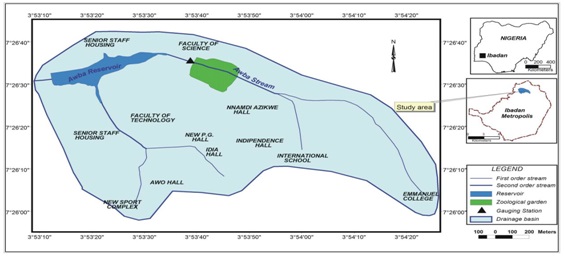Evaluation of Radiological Hazard Indices and Environmental Safety in Soil Samples from Different Source Term Within the Tributaries of Awba Dam in the University of Ibadan
Keywords:
In Situ Measurement, Assessment Dose, Radioactivity Concentrations, Ionize RadiationAbstract
Artificial and Natural radionuclides exist in environmental materials such as water, soil, rocks, and plant as well as in animals and human body tissues. Therefore, human being and environment are at constant radiation exposure. Regarding this, the present study aimed to determine the specific activities of radionuclides and perform the risk assessment study to establish if there was a potential threat posed by radionuclides to humans and aquatic life in Awba dam, the University of Ibadan, due to untreated effluents discharge from the hall of residences. In this study, natural and artificial radioactivity concentrations were determined in soil samples from different source terms located along the banks of the input water discharge points into Awba dam, University of Ibadan, were collected and analyzed for natural radioactivity level using gamma-ray spectroscopy. A total of Twenty-eight sediment samples were collected for the measurement. Samples were collected one after the other along the banks of the source point. Prior to the collection of all the samples from each source point, both analogue and digital survey meter were used to ascertain the level of radiation in their immediate environment. The prepared sample was sealed and stored for a minimum of thirty-days to allow for radium equilibration with daughters nuclide. The range of the activity concentration due to ${}^{40}K$ was 2.023 to 1194.1 $BqKg^{-1}$ while those for ${}^{238}U$ and ${}^{232}Th$ were respectively 2.12 to 21.82 and 0.91 to 31.10 $BqKg^{-1}$. The total absorbed dose rate of the three radionuclides are $0.08-8.54$, $1.0-10.01$, $0.26-10.56$ $nGy^{-1}$ respectively, for the result shows that the total concentration of ${}^{232}Th$ is much higher than that of ${}^{238}U$ while ${}^{40}K$ leads the table of radioactivity concentration. The entire soil sample from different source term does not pose any significant radiological threat to the general public, and the activity concentration of the radionuclides in the sediments are equally low. No artificial sources of radionuclides were detected in any of the soil and sediment samples of the Dam.
References
A El-Taher, M.A.M. Uosif, and A. Orabi, Natural Radioactivity Levels and Radiation Hazard indices in Granite from Aswan to Wadi El- Allaqi South Eastern Desert – Egypt. Radiation. Protection Dosimetry 124 (2), 2007, 148-154.
Alrefae T, Nageswaran TN (2013) Radioactivity of long-lived gamma emitters in rice consumed in Kuwait Journal of the Association of Arab Universities for Basic and Applied Sciences13:24-27 doi:10.1016/j.jaubas.2012.07.005
Ibrahim F. A. and Mohammad I. A. (2009) "Soil radioactivity levels and radiation hazard assessment in the highlands of northern Jordan." Radiation Measurements. 44(1): p. 102-110.
ICRP International Commission on Radiological Protection, Recommendations of the International Commission on Radiological Protection. ICRP publication 60, Annuals of the ICRP 21 (1-30). Pergamon press, Oxford, 1990.
Kuma, A., et al., (2003) "Natural activities of 238U, 232Th and 40K in some Indian building materials." Radiation Measurements, 36 1-6: p. 465-469.
Ononugbo C.P. and B. U. Nwaka Natural Radioactivity and Radiological Risk Estimation of Drinking Water from Okposi and Uburu Salt Lake Area, Ebonyi State, Nigeria5(3): 1-15, 2017; Article no.PSIJ.31625 ISSN: 2348-0130
Radiological laboratory Sample Analysis Guide for incidents of National significance radionuclide in water. (United States Environmental Protection Agency, January 2008). EPA 402-R-07-007.
UNSCEAR. (2000). United Nations Scientific Committee on the Effects of Atomic Radiation, “Sources and Effects of Ionizing Radiation. Report Vol.1 to the General Assembly, with scientific annexes, (United Nations Sales Publication, United Nations, New York)
United Nation Scientific Committee on the effects of atomic radiation. Radiological protection bulletin No224, New york. 2003.
U.S. NUCLEAR REGULATORY COMMISSION (USNRC), US Government Printing Office, Washington, D.C.20555 (2014).
UNSCEAR. Sources and effect of ionizing radiation. Unscear, 2008 Report to the General Assembly with Scientific Annes.2008.





